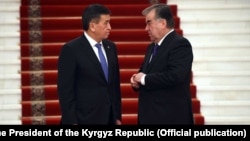The scrubby foothills around the Kyrgyz village of Ak-Sai and the Tajik exclave of Vorukh have been a hot spot for a decade, with scores of people injured -- and a few killed -- in regular clashes along the still-unmarked border there.
The presidents of Kyrgyzstan and Tajikistan were already planning to meet nearby on July 26 to discuss border issues.
But when violence around Vorukh left one person dead and at least 27 more wounded on July 22, it underscored the importance of resolving this longstanding border dispute.
By July 23, despite fresh reports that a Kyrgyz border guard had received a gunshot wound, officials in both countries were saying the situation had stabilized. But the road to the area remained closed, and Kyrgyz authorities decided to evacuate 315 people from the region. Fifteen people were reportedly in hospitals in Kyrgyzstan; four were said to be hospitalized in Tajikistan (eight others had been discharged with minor injuries); and family members were preparing to bury 52-year-old Tajik national Jaloliddin Karoev, who had died of a gunshot wound to the eye.
Each side offers a slightly different account of what happened on the evening of July 22, typical of all the several-times-a-year clashes in recent years along the Kyrgyz-Tajik border.
In this case, both sides seem to agree that it was the raising of a Tajik flag by individuals from the Vorukh exclave that sparked this latest violence.

Tajik President Emomali Rahmon is reportedly due to visit Vorukh this week for the first time in 26 years, so residents were said to be preparing for their VIP guest.
Where exactly the flagpole was set up is one of the most fiercely disputed questions. Some Ak-Sai residents said it was put on disputed territory; some Vorukh residents insist it was firmly within the exclave.
There are also reports that Ak-Sai residents put up a sign in the nearby Dacha area that read "Ak-Sai" in response to the raising of the Tajik flag and that Vorukh residents quickly destroyed it.
In any case, the fighting started shortly after the Tajik flag was raised, with people on each side throwing stones. Soon, someone brought hunting rifles, not unusual in the area since hunting is common in the nearby mountains. The four hospitalized Tajiks, one of them a police officer, were reportedly being treated for gunshot wounds; 12 of the 15 hospitalized Kyrgyz were being treated for gunshot wounds.
The incident does not appear to have changed President Rahmon’s plans to visit Vorukh, or to meet with Kyrgyz President Sooronbai Jeenbekov in the nearby Tajik town of Isfara, on July 26.
In fact, the violence could give further impetus to Rahmon and Jeenbekov to work harder to resolve their countries’ border disputes.
Previously, clashes have led to officials in both countries vowing to find solutions to the problems of residents near the border. But despite agreements on things like joint patrols of the border and locally arranged joint celebrations of holidays like Norouz, the situation in the Vorukh-Ak-Sai area seems to be worsening. Previous scuffles involved sticks and stones; the use of firearms marks an escalation, and cooling heads now will be even more difficult.
Most of the 315 Kyrgyz citizens evacuated from the area this week are women and children. Fifty-five of them are temporarily living with family members in other areas of southern Kyrgyzstan, while the other 260 people are temporarily living in tents in the provincial capital, Batken. The version of events they tell others in southern Kyrgyzstan will almost surely influence how those people view tensions along the Tajik border.
Similarly, Tajik citizens being treated in the hospital are likely to emerge with a version of events that holds Kyrgyz responsible for the violence on July 22.
It is significant that, for once, the two presidents are meeting near the site of a conflict to discuss the problems.
Previous talks between leaders of the two countries were conducted by telephone or on the sidelines of summits of multilateral organizations like the Shanghai Cooperation Organization or the Commonwealth of Independent States.
So Rahmon and Jeenbekov's face-to-face meeting this week could provide an opportunity for progress.
But the challenge is ensuring that they leave behind real change once they're gone.







